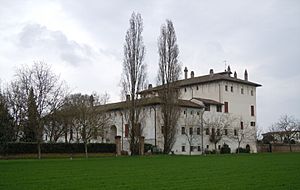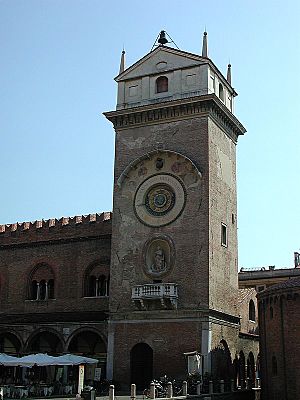Luca Fancelli facts for kids
Luca Fancelli (born around 1430, died around 1502) was a talented Italian architect and sculptor. He designed many important buildings during the Renaissance period.
Contents
Luca Fancelli's Early Life and Training
Luca Fancelli was born in Settignano, a small town near Florence, Italy. We don't know much about his early life. It's a bit of a mystery! But we do know he learned how to work with stone. He trained as a stonecutter and a stonemason, which means he was skilled at shaping and building with stone. He also studied under a very famous architect named Filippo Brunelleschi.
Disputed Designs and Famous Buildings
A writer from the 1500s, Giorgio Vasari, wrote about many artists. Because of him, there are some questions about which buildings Fancelli actually designed.
For example, Fancelli probably designed the Palazzo Pitti in Florence. This was a huge palace for a rich family friend of the Medici family. But Vasari said that Brunelleschi designed it, even though Brunelleschi had died before work started. Many people think the palace style doesn't match Brunelleschi's work.
Fancelli might also have designed a part of the SS. Annunziata church in Florence. This part is called the tribune. But this design is also debated.
Working for the Gonzaga Family in Mantua
In 1450, Fancelli moved to Mantua, another important city in Italy. There, he worked for the powerful Gonzaga family, specifically for Marquis Ludovico III.
Mantua was a very important place for art and artists during this time. The Gonzaga family hired many famous artists, like Mantegna and Leon Battista Alberti.
Fancelli became a main architect for the Gonzaga family. He helped build the churches of San Sebastiano (started in 1460) and Sant'Andrea (started in 1472). The main plans for these churches were drawn by Alberti. But Fancelli played a big role in building them, especially Sant'Andrea, which began shortly before Alberti passed away.
Designing the New Royal Palace
Later, Marquis Federico I (Ludovico III's son) decided to build a new royal palace in Mantua. Fancelli was chosen to design a special part of this palace. This section was called the Domus Nova, which means "New House." It was built around a clock tower.
Fancelli worked on the Domus Nova from 1478 to 1484. However, the entire palace wasn't finished until the 1600s.
Luca Fancelli's Later Years
Just like his early life, the end of Fancelli's life is also a bit of a mystery. He is not mentioned in any written records after 1494.
See also
 In Spanish: Luca Fancelli para niños
In Spanish: Luca Fancelli para niños



